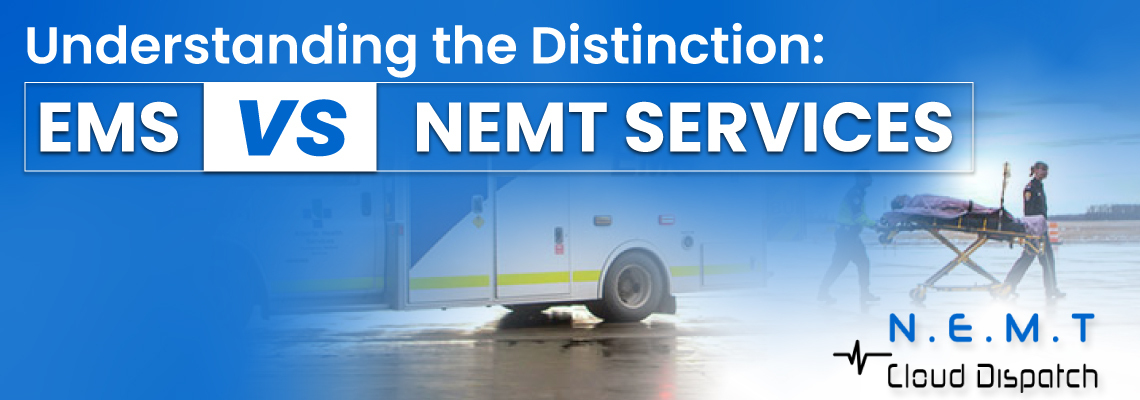Blog

When it comes to medical transportation services, understanding the difference between Emergency Medical Services (EMS) and Non-Emergency Medical Transportation (NEMT) is crucial. While both services involve transporting individuals with medical needs, they cater to different situations and requirements.
This blog post will delve into the key differences between EMS and NEMT services, examining their purposes, operations, transportation costs, licensing and certification requirements, regulatory frameworks, market size, growth, and the importance and benefits they offer.
Emergency Medical Services (EMS) are critical in providing immediate and life-saving care during emergencies. Let's explore the specifications:
EMS serves as the frontline response system for emergencies, such as accidents or critical medical conditions.
EMS professionals, including paramedics and Emergency Medical Technicians (EMTs), are trained to provide urgent medical care on-site and stabilize patients.
EMS personnel transport patients to the nearest hospital for further treatment, ensuring timely access to medical care.
Regarding certification requirements for EMS, it primarily refers to the certification levels for EMS personnel. The certification levels for EMS personnel include the following:
Basic level of certification providing training in essential emergency medical care skills.
Intermediate level of certification with additional training and skills beyond the EMT level.
Advanced level of certification with extensive training in advanced life support and comprehensive pre-hospital care.
Non-Emergency Medical Transportation (NEMT) provides transportation services for individuals who require medical assistance but do not have an immediate or urgent medical need.
Let's have a look at the specifications:
NEMT focuses on providing transportation for non-emergency medical appointments and serves individuals with disabilities or limited transportation options.
NEMT ensures individuals can access necessary healthcare by providing transportation to scheduled medical appointments.
NEMT specializes in accommodating individuals with mobility challenges, ensuring safe and reliable transportation for medical purposes.
It's important to note that certification requirements can vary from state to state, but the basics are mentioned here:
Want to Dive Deeper into the Numbers? Read more about Certifications Needed To Start a NEMT Business.
Let’s have a keen look at the points that set both services apart:
EMS responds to emergencies and provides immediate life-saving care, while NEMT caters to non-emergency medical transportation needs.
EMS operates as an emergency response system, activated through 911 calls or emergency communication channels, while NEMT involves coordination between government programs, intermediaries, and transportation providers.
EMS transportation costs vary based on the level of care required and the distance traveled, often covered by insurance. NEMT transportation costs vary but are often covered by Medicaid or government programs for eligible individuals.
EMS professionals require certification from national or state bodies, while NEMT drivers need a valid driver's license, clean driving record, and first aid and CPR certification.
EMS and NEMT services are subject to regulations ensuring quality, safety, and compliance. EMS regulations focus on certification, training, and equipment standards, while NEMT regulations encompass vehicle standards, driver training, and provider regulations.
The EMS and NEMT industries are experiencing significant growth and are poised for further expansion in the coming years. Understanding the market size, trends, and projected growth is essential for stakeholders and investors in these sectors.
The EMS market is expected to reach $20.9 billion by 2027, driven by an aging population, increased road accidents, and a rise in emergency cases.
The NEMT market is forecasted to reach $9.5 billion by 2028, fueled by the growing demand for transportation services for the elderly and disabled.
By understanding the market size, monitoring trends, and anticipating future developments, stakeholders can make informed decisions and contribute to advancing these vital healthcare sectors.
In addition to emergencies, both EMS and NEMT contribute to preventive and regular healthcare. While EMS focuses on emergencies, NEMT is vital in helping individuals attend non-emergency appointments, such as regular check-ups, follow-up visits, and therapeutic sessions.
In addition, NEMT helps individuals manage their health conditions, receive necessary treatments, and prevent complications by ensuring transportation for these appointments.
EMS and NEMT services contribute to the overall efficiency of the healthcare system. EMS plays a crucial role in reducing overcrowding in emergency departments by providing appropriate care on the scene and transporting only those patients who require hospitalization. This helps allocate resources effectively and ensures that emergency departments are available for those in immediate need.
NEMT, on the other hand, helps reduce missed appointments and late arrivals, improving the overall efficiency of healthcare providers and preventing unnecessary delays in treatments.
Finally, Understanding the differences between EMS and NEMT services is essential for healthcare professionals, patients, and individuals needing medical transportation. While EMS serves as the first line of response in emergencies, providing immediate life-saving care and transportation to hospitals, NEMT focuses on non-emergency medical transportation for individuals with disabilities or limited mobility.
So, both services play critical roles in ensuring accessible and timely medical care, improving health outcomes, and supporting the overall efficiency of the healthcare system. By recognizing their distinctions and benefits, we can better utilize these services and contribute to the well-being of needy individuals.
5/5(2 votes)
About the author

As NEMT Cloud Dispatch Marketing Director, Tom has expertise in NEMT company and performs well in marketing, utilizing different strategies to increase the Nemt Cloud Dispatch business. His dedication extends to offering NEMT providers with advanced software for massive development. Tom is one of the industry's experts and shares his experience with readers through interesting content on home care, medical billing, medical transportation, and marketing.
